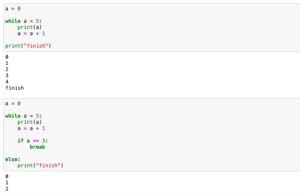目次
Pandas
前回、繰り返し関数whileの使い方を勉強しました。
あわせて読みたい


【Python基礎】while:繰り返し
while 前回、文字列や数値をゼロ埋め(ゼロパディング)する方法を勉強しました。 今回はPython(というよりもプログラミングとして)の基礎でやる繰り返し文「while」…
今回はPandasの行・列のデータをランダムに取得する方法を見ていきましょう。
通常、列は項目を、行が1つのデータとして扱うことが多いので、行をランダムに取得する方法が特に役立つかと思います。
まずデータとしてはこんな感じに作ってみました。
import pandas as pd
data = [[1, 1, 1], [2, 4, 8], [3, 9, 27],[4, 16, 64], [5, 25, 125]]
df = pd.DataFrame(data)
print(df)
実行結果
0 1 2
0 1 1 1
1 2 4 8
2 3 9 27
3 4 16 64
4 5 25 125これを使って、データをランダムに取得する方法を見ていきましょう。
ランダムにデータを1行取得
まずは1番の基本。
ランダムにデータを1行取得する方法です。
ランダムにデータを1行取得するには、「データフレーム名.sample()」を用います。
selected_row = df.sample()
print(selected_row)
実行結果
0 1 2
3 4 16 64ランダムにデータを1列取得
ランダムにデータを1取得するには「axis=1」のオプションを追加します。
つまり「データフレーム名.sample(axis=1)」とします。
selected_column = df.sample(axis=1)
print(selected_column)
実行結果
2
0 1
1 8
2 27
3 64
4 125重複無しで複数のデータをランダムに取得
ランダムに取得したデータが重複しないようにデータを取得するには「n=取得するデータ数」のオプションを追加します。
selected_row3 = df.sample(n=3)
print(selected_row3)
実行結果
0 1 2
0 1 1 1
1 2 4 8
4 5 25 125ちなみにこの場合、データが重複しないためにはnはデータフレーム内の全データ数よりも少ない数である必要があります。
もしデータフレーム内の全データ数よりも多い数を指定した場合、エラーとなります。
selected_row10= df.sample(n=10)
print(selected_row10)
実行結果
---------------------------------------------------------------------------
ValueError Traceback (most recent call last)
Input In [21], in <cell line: 1>()
----> 1 selected_row10= df.sample(n=10)
3 print(selected_row10)
File /Library/Frameworks/Python.framework/Versions/3.10/lib/python3.10/site-packages/pandas/core/generic.py:5446, in NDFrame.sample(self, n, frac, replace, weights, random_state, axis, ignore_index)
5443 if weights is not None:
5444 weights = sample.preprocess_weights(self, weights, axis)
-> 5446 sampled_indices = sample.sample(obj_len, size, replace, weights, rs)
5447 result = self.take(sampled_indices, axis=axis)
5449 if ignore_index:
File /Library/Frameworks/Python.framework/Versions/3.10/lib/python3.10/site-packages/pandas/core/sample.py:150, in sample(obj_len, size, replace, weights, random_state)
147 else:
148 raise ValueError("Invalid weights: weights sum to zero")
--> 150 return random_state.choice(obj_len, size=size, replace=replace, p=weights).astype(
151 np.intp, copy=False
152 )
File mtrand.pyx:965, in numpy.random.mtrand.RandomState.choice()
ValueError: Cannot take a larger sample than population when 'replace=False'重複ありで複数のデータをランダムに取得
重複ありで複数のデータをランダムに取得するには「n=取得するデータ数」と併せて「replace=True」のオプションを追加します。
selected_row3_replace = df.sample(n=3, replace=True)
print(selected_row3_replace)
実行結果
0 1 2
0 1 1 1
0 1 1 1
4 5 25 125「replace=True」のオプションがある場合、取得するデータ数はデータフレーム内の全データ数を超えても問題ありません。
selected_row10_replace = df.sample(n=10, replace=True)
print(selected_row10_replace)
実行結果
0 1 2
1 2 4 8
1 2 4 8
1 2 4 8
4 5 25 125
0 1 1 1
1 2 4 8
2 3 9 27
0 1 1 1
2 3 9 27
0 1 1 1こういったランダムにデータを取得する系の関数はデータを取得し、データベースを作成する場合ではなく、そのデータベースを使って何かをする際に結構役立ちます。
次回はmatplotlibとPILを使って、アニメーションのグラフを作成してみましょう。
あわせて読みたい


【matplotlib】matplotlibとPILを使ってGIFアニメーショングラフ作成:どんどん伸びる線グラフ[Python]
MatplotlibとPIL 前回、Pandasで行・列のデータをランダムで取得する方法を勉強しました。 今回から何回かはMatplotlibとPILを使って、GIFアニメーショングラフとして動…
ではでは今回はこんな感じで。

コメント